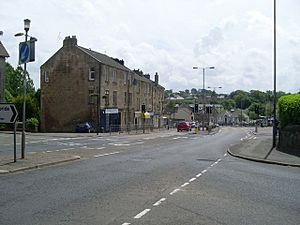Busby, East Renfrewshire facts for kids
Quick facts for kids Busby |
|
|---|---|
 Main Street in 2009 |
|
| Population | 3,310 (2020) |
| Council area | |
| Lieutenancy area | |
| Country | Scotland |
| Sovereign state | United Kingdom |
| Post town | GLASGOW |
| Postcode district | G76 |
| Dialling code | 0141 |
| Police | Strathclyde |
| Fire | Strathclyde |
| Ambulance | Scottish |
| EU Parliament | Scotland |
| UK Parliament |
|
| Scottish Parliament |
|
Busby is a small village located in East Renfrewshire, Scotland. Even though it's part of the wider Glasgow urban area, it's not officially part of Glasgow city. Busby sits on the White Cart Water river, about 6 miles (10 km) south of Glasgow's city centre. It's also very close to the town of Clarkston.
Contents
History
Busby has been a place where people live for at least 700 years! Long ago, it was called Bushby. The modern village we see today really started to take shape in the 1780s because of some big changes.
How Busby Grew
Before the 1780s, Busby was just a few small cottages. They were scattered along a path that went from Carmunnock to Mearns. This path crossed the River Cart near a spot called Newford. The original village was near where the Busby railway station is now. For many centuries, people worked the land around this central settlement.
However, by the 1780s, the landowner started to change things. The old village was cleared away. The people who lived there moved to new farms like Easter Busby and Wester Busby. The name Busby might have disappeared if not for something important happening across the River Cart.
The Rise of Mills
A big change happened in 1780 with the building of Busby's first cotton mill. This mill was at Newmill, on the other side of the River Cart. Busby and Newmill already had older mills. Busby had a Meal Mill (for grinding grain) and a Waulk Mill (for processing cloth). Newmill also had two mills near a waterfall.
But the cotton mill built in 1780 was much bigger than these old mills. It brought many families to live in the area. Because of this, the centre of Busby moved from the old village on the Lanarkshire side of the river to Newmill on the Renfrewshire side. A second cotton mill opened in 1790. Then, a Bleachfield and Printworks (places for treating and printing on cloth) were built six years later. These industries gave jobs to many people and helped the modern village of Busby grow.
New Roads and Bridges
Another important change in the 1780s was a new road. This road went from Paisley to East Kilbride and passed right through Busby. The first Busby Bridge was built around 1785 as part of this new road. It replaced an older place where people used to cross the river. This new road made the Paisley—East Kilbride route more important than the old Carmunnock—Mearns path.
Busby wasn't the easiest place to build a village. But it grew because the River Cart provided power for the mills. From the 1780s, the village became centred on a hilly area called "The Bank." Busby's Main Street was built on a very steep hill. The road leading to Clarkston has even collapsed a few times over the years!
The Railway Arrives
More big changes came to Busby in the 1860s. The Printworks helped bring the railway to the village. Building the railway to Busby was tricky. A huge viaduct (a long bridge with arches) was needed to cross Busby Glen. This viaduct was the most expensive part of the railway line. Today, the viaduct is a famous landmark in the area.
The railway also changed the East Kilbride Road. The road bridge under the station is quite low. It can be a problem for tall vehicles like buses, which have sometimes hit it. The railway brought a second wave of growth to Busby starting in the 1870s. As the mills and printworks slowly declined, more people moved to Busby to live and travel by train to work in nearby towns. This helped Busby continue to thrive into the 20th and 21st centuries.
Fun Places to Visit
Busby has several parks where you can relax and play.
Parks for Play
The main parks are the large Busby Glen Park, which is near the viaduct. There's also Southview Park and Spider Park.
Old Buildings and Landmarks
Many of the very old buildings in west Busby, including most of the old mills, are no longer there. However, one old building remains on Riverside Terrace. Busby's school and church are both very old buildings. Much of the eastern part of Busby is now a special conservation area, meaning its historic character is protected.
The Busby Hotel is also a well-known building in the area. It was renovated in 2014. Other old places include The White Cart pub, which was made from two different houses, and the Cartvale pub on Busby's main street.
Famous People from Busby
Thomas Donohoe, who was a very important person in starting football in Brazil, was born and grew up in Busby. There's a statue in his honour at the car park in Mary Young Place.
Clubs and Groups
- Busby Lawn Tennis Club
Images for kids
See also
 In Spanish: Busby para niños
In Spanish: Busby para niños



